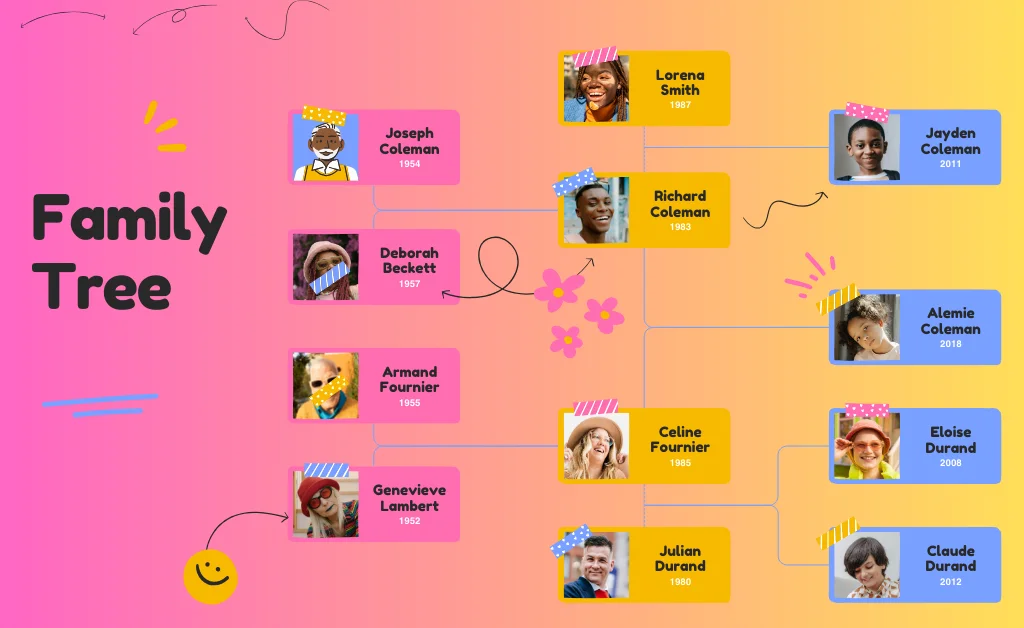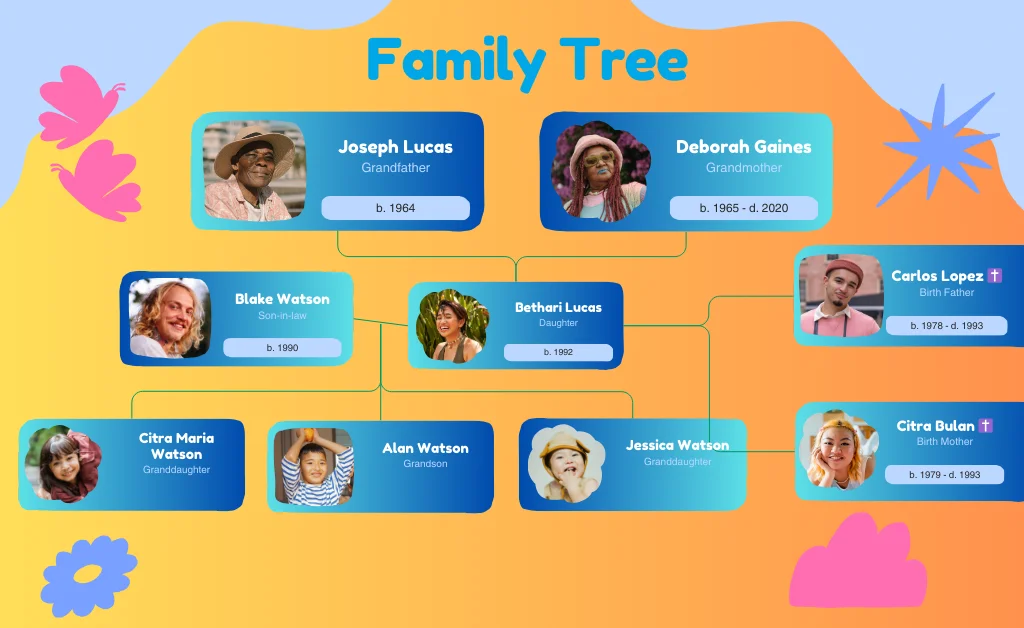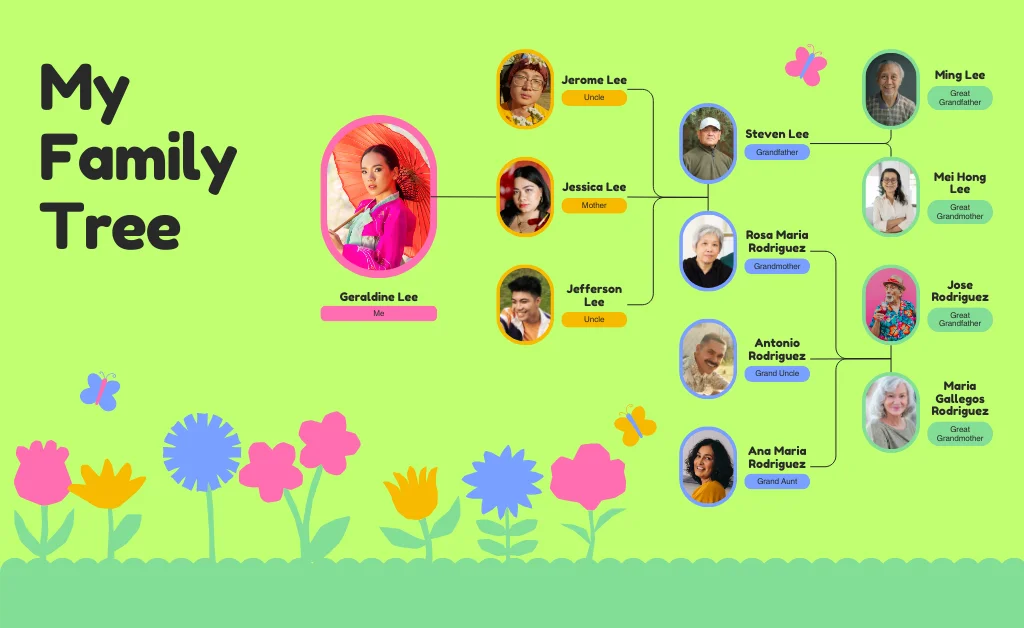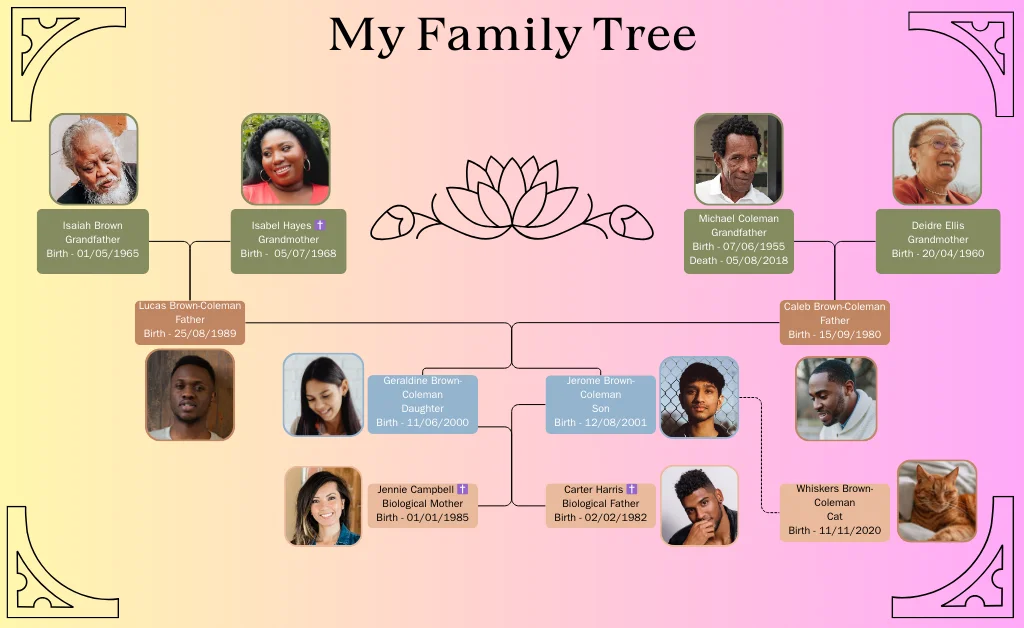Family Tree is very close to our hearts; everyone wants to make their best Family Tree Diagram or Chart with their loved ones. Creating a family tree is a great way to showcase the fascinating details of your heritage.
Have you ever looked at old family photos and wondered about the stories behind those vaguely familiar faces that seem to resemble your own?
Tracing your ancestry back as far as the branches grow can uncover captivating details about the very building blocks of your identity. A family tree diagram serves as the perfect vehicle for mapping out the twisting vines of your lineage in an intuitive, visual format.
In this comprehensive guide, we will explain what exactly a family tree is, the multitude of benefits exploring your genealogy can offer, and provide a step-by-step tutorial for creating a personalized diagram of your family’s history. Let’s discover some secrets hiding in the leaves of your family tree!
What Is a Family Tree Diagram?

A family tree diagram visually depicts the ancestry and interrelationships of a family across generations. Structured like an actual tree, it has you as the “root” at the base, branching out to parents, grandparents, and earlier ancestors, forming the “leaves” and “limbs.”
Lines connect family members to demonstrate relationships. Individuals are represented by shapes like boxes or circles containing names, photos, dates, and other relevant details.
The study of family histories and pedigrees is called genealogy. Aristocrats and nobles historically used elaborate family trees to verify heritage and succession rights. Today, anyone can create one to explore their lineage!
Key Benefits of Making a Family Tree
Crafting a family tree offers many worthwhile rewards, including:
- Discovering Your Roots – Learn unknown details about your ancestors and ethnic origins. A 2020 study found that 75% of people who make family trees uncover meaningful new information about their families.
- Appreciating Your Identity – Seeing all the pieces come together provides perspective on how you fit into the wider tapestry of your heritage.
- Tracking Health History – Identify conditions and diseases common in your bloodline so you can watch for symptoms. Over 85% of genealogists have used their trees to pinpoint genetic health risks.
- Bonding with Relatives – Shared interest in ancestry can strengthen family ties. Compare details, swap stories, plan reunions, etc.
- Preserving Your Legacy – Pass down a meaningful family heirloom to future generations. Some trees have been actively maintained for centuries!
Step-by-Step Instructions on Building Your Family Tree
Follow these simple steps to create your own beautiful family tree masterpiece:
Step 1: Gather Information from Relatives
Reaching out to family members is crucial for collecting names, dates, locations, and anecdotes to incorporate. Typical sources include:
- Grandparents, parents, aunts, uncles, siblings
- Birth/marriage/death certificates
- Old diary entries, letters, photo albums
- DNA tests – These have become popular, with over 40 million people taking one as of 2022!
Use interviews and family group chats to crowdsource data. The more details you unearth, the richer your diagram will be!
Step 2: Research Online Databases
Many useful online genealogical databases contain billions of historical records to aid your search.
Helpful sites like Ancestry.com, FamilySearch.org, FindMyPast.com, and MyHeritage let you delve into:
- Censuses
- Immigration/travel records
- Military registers
- Newspaper archives
- Public family trees – Tap into information compiled from other users’ discoveries!
Plug in the names and info gathered from relatives to uncover more ancestral branches.
Step 3: Map Out a Draft Version
Once your fact-finding mission is complete, it’s time to start structuring your diagram. Begin with yourself at the root and add layers moving up through parents, grandparents, and great-grandparents for as far back as data allows.
Standard trees showcase blood relatives only. But you can take creative license to include in-laws, adopted children, close family friends – whoever holds significance in your history.
Use pencil and paper to sketch things out. Or draft the blueprint digitally using Venngage’s intuitive, user-friendly family tree templates and online editor. Their Family Tree Maker tool lets you effortlessly bring beautiful, custom designs to life.
Step 4: Input Relevant Personal Details
With the framework in place, now populate by entering pertinent information for each family member into their corresponding shape.
Typical data fields to fill in are:
- Full name
- Photo
- Birth/marriage/death years
- Location(s) lived
- Notable achievements
Venngage offers hundreds of icons, graphics, and illustrations to spice things up visually. Their stock image library contains pictures perfect for ancestral diagrams.
If desired, get creative with colors and fonts to highlight different branches or generations!
Step 5: Connect Family Nodes with Lines

Once all individuals are plotted, link with lines representing familial bonds. Vary line styles to distinguish between relationships:
- Spouses
- Parent-child connections
- Siblings
Double lines for adopted/step-relatives make flows clear, too. Position circles and boxes close to one another for nuclear family units. Lengths of lines can separate degrees of distance.
Step 6: Fact Check and Finalize Design
Before completion, vet your masterpiece for accuracy by confirming details with family experts, cross-referencing historical files, etc.
Performing due diligence avoids mistaken linkages.
Lastly, polish visual presentation by ensuring proper name spelling, date precision, color consistency, balanced layout, and other aesthetic elements for perfection.
Inspiring Examples of Family Tree Diagrams
Check out these wonderfully unique, real-world family trees others have created:
The above example creatively uses gender icons instead of photos or names, neatly organizing generations with color coordination. Clean and contemporary!

This horizontal format with ancestor generations flowing right and left has a nice fluidity. Inviting color scheme, too!

Sometimes, simple is best. This tree nails basics beautifully – photos, names, and birth/death years, all on a framed trunk background.
There are so many inventive ways to construct your family’s narrative visually. Let these spark ideas for your own custom creation!
How many generations back should I go?
It depends on your goals and how much-verified information you can obtain. Most standard trees cover 3-4 generations, including you. But advanced genealogists plot out 5 or more!
Can I include non-blood relatives like stepsiblings?
Absolutely! The diagram should reflect all meaningful figures from your family history. Adopted children, family friends, and in-laws can earn a place.
What’s the best software for building trees digitally?
These are the best softwares where you can make your family tree for free.


